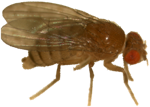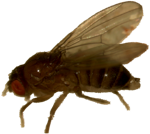| The
POOL Lab Research People Publications Genomes |
 Why study Drosophila?
Why study Drosophila?
 by John Pool When I made my first fly-collecting expedition to Africa, visiting fruit stands and bars in Cameroon to set out fly traps, I remember that many people seemed quite amused that I had traveled across the globe to study these seemingly insiginificant creatures. I can easily understand why. By most human standards they are not beautiful, they are not cute and cuddly, and they lack the majesty of an elephant or a gorilla. Yet they have quite a following in science, and while I make no attempt to give a full explanation of their value to biology, I will try to explain why Drosophila melanogaster is an ideal study system for my lab's research into the genetic basis of adaptive evolution. D. melanogaster became a leading model organism in population genetics for many of the same reasons that it has been a mainstay of classical and molecular genetics for over a century. It's easy to keep in the lab and has a short generation time, which is obviously helpful for controlled crosses and lab experiments. Fly stocks can also be inbred, which comes in very handy when we want to connect an adaptive phenotype to a causative locus in the genome. If we can phenotype multiple flies with the same homozygous genotype, and focus on mapping the effects of just one allele per locus instead of two, our job is going to be much easier. Of course, inbreeding carries caveats that are not always recognized, especially the exposure of rare deleterious recessive alleles that would seldom become homozygous in nature, but this can be overcome by creating "controlled outbred" genotypes from crosses between pairs of inbred lines. Population genetics also benefits greatly from the sequencing of genomes that are homozygous, as linkage across extended haplotypes becomes clear. Largely homozygous genomes can be produced from inbred lines (Langley et al. 2012; Mackay et al. 2012), while fully homozygous genomes from haploid embryos can be generated by mating females to males carrying a special mutation (Langley et al. 2011). D. melanogaster is an outcrossing species, and we can study a large number of unrelated fly stocks collected at the same location and time, which means that genetic variation corresponds to basic assumptions of population genetic theory. The species' compact genome (120 Mb) means that sequencing a large number of complete genomes from each population is quite economical, and high sequencing depth produces consensus genome sequences with very few errors. The species has undergone noteworthy adaptive events in its recent history - first the transition from a wild-living African species to one essentially dependent on human habitation, and secondly its worldwide expansion, which has taken it into environments much different from its sub-Saharan ancestral range (such as Madison, Wisconsin). Its occupation of diverse environments provides excellent raw material for the study of local adaptation. For example, my lab is assembling pairs of population samples that are geographically close together but come from contrasting altitude environments. The close relationships these populations share across most of the genome give us excellent power to detect loci that differ between populations due to natural selection. Once we do detect a gene underlying an adaptive phenotypic difference between populations, the strongest advantages of D. melanogaster become apparent. The species' well-annotated genome may help to refine our ideas about the specific target of selection. Even more significantly, a wide range of molecular, genetic, and transgenic tools is now at our disposal to reveal the precise mutations responsible for adaptive evolution and their molecular mechanisms. A prime example comes from our pigmentation research: after finding population genetic evidence of selection acting on the regulatory region of the ebony gene (Pool and Aquadro 2007), I collaborated with Mark Rebeiz and Sean Carroll, who ultimately used transgenic reporter assays to identify five causative mutations (Rebeiz et al. 2009). Three of these were in the abdominal enhancer, while the other two mutations were in a nearby repressor and were initially identified based on population genetic evidence. An important component of the above research's success in identifying adaptive mutations was its focus on the genetic basis of adaptation within species, rather than between distantly related species. In addition to giving us evidence for the adaptive nature of the trait (from geographic patterns of the phenotype, and from genetic variation at a causative locus), looking within species meant that few mutations at the causative locus differed between light and dark individuals, which was critical to efficient identification of the adaptive mutations. The molecular and transgenic toolkit showcased by that study, together with the amazing population genomic resources we now have available, make Drosophila melanogaster an ideal system for pursuing the genetic basis of adaptive evolution. |
Research People Publications Why Study Population Genetics? |